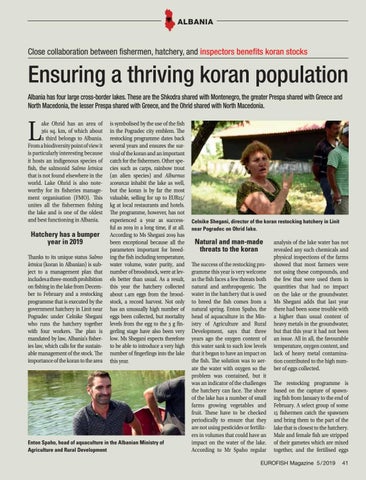ALBANIA
Close collaboration between ďŹ shermen, hatchery, and inspectors beneďŹ ts koran stocks
Ensuring a thriving koran population Albania has four large cross-border lakes. These are the Shkodra shared with Montenegro, the greater Prespa shared with Greece and North Macedonia, the lesser Prespa shared with Greece, and the Ohrid shared with North Macedonia.
L
ake Ohrid has an area of 361 sq. km, of which about a third belongs to Albania. From a biodiversity point of view it is particularly interesting because it hosts an indigenous species of fish, the salmonid Salmo letnica that is not found elsewhere in the world. Lake Ohrid is also noteworthy for its fisheries management organisation (FMO). This unites all the fishermen fishing the lake and is one of the oldest and best functioning in Albania.
Hatchery has a bumper year in 2019 Thanks to its unique status Salmo letnica (koran in Albanian) is subject to a management plan that includes a three-month prohibition on fishing in the lake from December to February and a restocking programme that is executed by the government hatchery in Linit near Pogradec under Celnike Shegani who runs the hatchery together with four workers. The plan is mandated by law, Albania’s fisheries law, which calls for the sustainable management of the stock. The importance of the koran to the area
is symbolised by the use of the fish in the Pogradec city emblem. The restocking programme dates back several years and ensures the survival of the koran and an important catch for the fishermen. Other species such as carps, rainbow trout (an alien species) and Alburnus scoranza inhabit the lake as well, but the koran is by far the most valuable, selling for up to EUR15/ kg at local restaurants and hotels. The programme, however, has not experienced a year as successful as 2019 in a long time, if at all. According to Ms Shegani 2019 has been exceptional because all the parameters important for breeding the fish including temperature, water volume, water purity, and number of broodstock, were at levels better than usual. As a result, this year the hatchery collected about 1.4m eggs from the broodstock, a record harvest. Not only has an unusually high number of eggs been collected, but mortality levels from the egg to the 3 g fingerling stage have also been very low. Ms Shegani expects therefore to be able to introduce a very high number of fingerlings into the lake this year.
Enton Spaho, head of aquaculture in the Albanian Ministry of Agriculture and Rural Development
Celnike Shegani, director of the koran restocking hatchery in Linit near Pogradec on Ohrid lake.
Natural and man-made threats to the koran The success of the restocking programme this year is very welcome as the fish faces a few threats both natural and anthropogenic. The water in the hatchery that is used to breed the fish comes from a natural spring. Enton Spaho, the head of aquaculture in the Ministry of Agriculture and Rural Development, says that three years ago the oxygen content of this water sank to such low levels that it began to have an impact on the fish. The solution was to aerate the water with oxygen so the problem was contained, but it was an indicator of the challenges the hatchery can face. The shore of the lake has a number of small farms growing vegetables and fruit. These have to be checked periodically to ensure that they are not using pesticides or fertilizers in volumes that could have an impact on the water of the lake. According to Mr Spaho regular
analysis of the lake water has not revealed any such chemicals and physical inspections of the farms showed that most farmers were not using these compounds, and the few that were used them in quantities that had no impact on the lake or the groundwater. Ms Shegani adds that last year there had been some trouble with a higher than usual content of heavy metals in the groundwater, but that this year it had not been an issue. All in all, the favourable temperature, oxygen content, and lack of heavy metal contamination contributed to the high number of eggs collected. The restocking programme is based on the capture of spawning fish from January to the end of February. A select group of some 15 fishermen catch the spawners and bring them to the part of the lake that is closest to the hatchery. Male and female fish are stripped of their gametes which are mixed together, and the fertilised eggs
EUROFISH Magazine 5 / 2019
& +-((
41
